This is a rudimentary translation of articles from my book “Goddess Culture in Israel“. While it is far from ideal, it serves a purpose given the significance of the topic and the distinctiveness of the information contained. I have chosen to publish it in its current state, with the hope that a more refined translation will be available in the future.
The Riddle of the Megaliths
During the third phase of the Goddess culture, which falls within the Chalcolithic period, one significant development was the construction of megalith networks (from ‘mega,’ meaning large, and ‘lithos,’ meaning stone). Initially, in the Goddess culture, specific natural locations, notable rocks, and patterns in the landscape were made sacred. Eventually, people began to modify the natural shapes of rocks and landscapes. This evolution led to transporting rocks from different locations to create deliberate structures. By arranging large, initially natural, stones in specific patterns, nature was enhanced. These stones have long been considered archetypal symbols of sanctity, representing the Great Mother or, metaphorically, the skeletal bones of Mother Earth, even into historical times.
Thus, megalithic structures emerged globally, from England in the west to Central Asia in the east. Israel boasts some of the world’s most significant and impressive megaliths, including Rujum el-Hiri in the Golan Heights, the dolmens near Kibbutz Shamir, the tumuli flanking the Ramon Crater, the menhirs at Tel Gezer, the substantial rock embankments of Gal Jethro, the walls of the K Line in the Negev, among others. While some of Israel’s megaliths date to later periods (marking the dawn of recorded history), the practice originates in the Chalcolithic period, if not earlier.
The resemblance among megalithic sites worldwide is striking and prompts reflection. It appears as though knowledgeable individuals, possibly priests or priestesses, traveled from one location to another, guiding communities in the construction of sacred sites. They provided specific designs and dimensions for creating structures and layouts intended to attract divine forces or energies. These advisors also determined the optimal locations for megaliths to establish a comprehensive network that would enhance terrestrial energies across the landscape, thereby fostering plant growth and aiding human civilization.
This discussion leads us to the concept of earth energies: the rationale behind the construction of megalithic monuments, as unconventional and challenging as it may seem to a scientific audience, is attributed to the capacity of humans at the time, particularly women, to sense and harness the earth’s energies, which were envisioned as emanations from the body of the Great Mother. The primary aspect of the sacred feminine involved a deep connection to these earth energies. It’s important to consider that people in ancient times possessed more acute sensory perception and experienced more intense emotions, in part because the environment was less polluted by radiation, allowing them to more readily perceive and interact with these energies.
If we embrace the concept of the Earth as a living entity, as suggested by the Gaia theory, then the planet can be thought of as having meridians or energy lines traversing it. Analogous to how acupuncture targets specific points on the body to alleviate blockages and enhance energy flow, megalithic structures and standing stones serve a similar purpose for the Earth. Constructing stone circles, dolmens, megalithic complexes, and arranging stones in precise patterns and locations on the Earth’s surface are ways to amplify the planet’s energy fields. This approach to interacting with the Earth’s energies reflects an ancient understanding of the planet’s living systems and their importance to human and ecological well-being.
Megalithic construction commenced as early as the 8th millennium BC, evidenced by structures like the submerged stone circle at Atlit Yam. However, the zenith of its complexity and grandeur emerged in the Chalcolithic period, beginning in the 5th millennium BC and peaking in the 4th and 3rd millennia BC. This pattern of development was not unique to Israel but occurred globally. The enduring legacy and significance of megaliths are reflected in the continued use of tombstones, which serve as modern-day remnants of these ancient practices and their purposes.
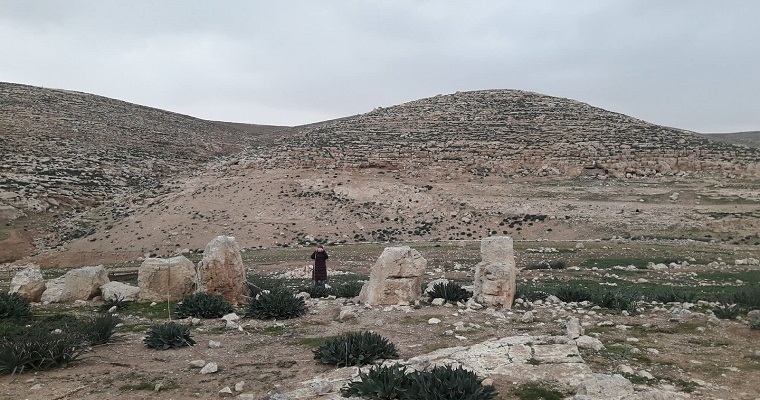
Megaliths represent some of the earliest significant public projects that humans collectively undertook, despite living in modest stone and mud brick dwellings that blended with the natural landscape. This was a global phenomenon. Opinions differ on the origin and spread of megalithic structures: some suggest they first emerged near the Atlantic Ocean and spread eastward, while others, including archaeologist Claire Epstein, argue that megalithic construction began in Israel and Transjordan, spreading westward from there.
Michael Freikman suggests that during the Goddess culture, humans perceived themselves as integral components of the landscape and the universe. This worldview was manifest in their construction of sacred sites, which were designed with reference to significant landscape features, human activity, and celestial bodies. Initially, these sites often incorporated natural and prominent elements of the landscape, like a cluster of rocks. However, over time, the construction of megalithic sites evolved to more complex designs that mirrored the broader landscape and the celestial dome above. These sites not only reflected the physical environment but, arguably, also resonated with the human form and the spiritual architecture of the universe.
Megalithic complexes, constructed globally, functioned as microcosms and axes mundi, bridging various planes of existence. Beneath these structures lay the realm of the deceased, while within their confines, humans reenacted creation myths and foundational narratives of their culture through rituals. Above, these sites reached toward the celestial realm, home to spirits, ancestors, and deities, oriented skyward. These megalithic sites narrated stories, crafted images, and engaged with visitors and the cyclical calendar. Their significance and power were invoked through visitation. Often, they served as venues for rites of passage, marking crucial transitions in the lives of individuals and communities.
In his detailed and significant PhD research on the Golan Megaliths [1], Michael Freikman demonstrates that the zenith of megalithic construction occurred during the Chalcolithic period, challenging the previously held belief that it peaked in the Bronze Age, at the dawn of recorded history. He reveals that the construction and utilization of megaliths persisted into the early historical period and the emergence of the first cities, continuing for another millennium. It was only with the rise of large Canaanite cities during the Middle Canaanite period (Middle Bronze Age, 2nd millennium BC) that megalithic structures faded from prominence [2].
Across Europe, the Balkans, Caucasus, Middle East, and Central Asia, the emergence of megalithic structures occurred simultaneously. The similarity in structure and orientation among these sites suggests a prehistoric connection between disparate regions. It’s implausible to consider that communities in England, Armenia, Greece, and Israel independently and simultaneously decided to construct stone circles and dolmens without some form of shared influence. This connection might have been energetic, archetypal, or rooted in a common belief system, particularly the reverence for the Goddess. As the belief in the Goddess waned, so too did the era of megalithic construction.
Mircea Eliade regards the megaliths as one of prehistory’s most profound mysteries, potentially linked to ancestral worship and the pursuit of immortality. Stone, as an archetypal symbol, epitomizes endurance and perpetuity. Its inherent roughness and hardness transform it into a hierophany—an embodiment of the sacred and the eternal, standing in stark contrast to the temporal and profane world. It’s a natural progression, then, for stones to be associated with the stars, which themselves are fixed entities in the heavens, representing another form of permanence. Simultaneously, stones are viewed as the initial crystallization and manifestation of Mother Earth, further anchoring them in the realm of the sacred and the timeless [3].
Mircea Eliade categorizes megaliths into three distinct types: The first type consists of standing stones, often referred to as Menhirs, which can achieve remarkable heights and weights, with some reaching several meters tall. The second type is the stone circle, a formation where stones are arranged in a circular pattern. The third type is known as a Dolmen, which resembles a portal; it is constructed from two vertically placed stones supporting a massive flat rock on top. Some of these capstones measure up to 20 meters in length and 3 meters in width, weighing hundreds of tons.
Eliade posits that megaliths serve a dual purpose: they are both expressions of the earth, embodying its quintessence and thus closely linked to the great Goddess through rocks, and at the same time elements of the sky, oriented towards celestial bodies. Their origin, whether from meteorites falling from the heavens or ejected from volcanoes, must have left a profound impression on ancient peoples. Many megalithic sites are deliberately designed to mirror the sky on one side and the earth on the other, this dual effect is achieved through their orientation, layout, dimensions, and forms.
Megaliths sparked the human imagination and were seen as creations of giants; alternative theories suggest they were constructed by enlightened beings or even aliens from outer space for energetic reasons. While modern perspectives may not align with these interpretations, it’s plausible that ancient people held such beliefs, attributing magical functions to these structures. It’s crucial to recognize that the ancients perceived the world differently from us. Additionally, we often assume that the Earth’s conditions, in terms of atmosphere, electrical conductivity, and energies, have always been as they are today, which may not be the case. The atmosphere in ancient times could have been more charged and functioned differently, likely cleaner, making the impact of the stones on ancient peoples something we might struggle to understand now. Today, the air is polluted, laden with dust, and saturated with interference and electromagnetic waves, obscuring phenomena such as the appearance of angels, influences, and holiness. In the past, however, the Earth’s condition was different; nature radiated with a supernatural glow, the realms were more intertwined, and under those circumstances, stones might have held a different significance and purpose, serving as conduits for spiritual light.
Some alternative theories propose that megaliths are much older than mainstream archaeology currently acknowledges, suggesting their construction commenced over 10,000 years ago. These theories highlight the presence of universal construction principles applied to megaliths globally, leading to speculation about a singular, global source of megalithic architecture. Proposed origins include Egypt, Atlantis, an unidentified prehistoric culture that spanned the globe, deeply attuned to the Earth’s energies. This culture might have possessed a form of religion disseminated by missionaries, with megalithic complexes serving as its sacred sites or “churches.” Characterized by their deliberate placement in relation to the Earth and their orientation towards celestial bodies, stone circles, menhirs, dolmens, and similar structures are thought to comprise a global energetic network. This network is theorized to have energized the Earth, linking it to the cosmos, thereby fostering prosperity and inspiration.
To unravel the “riddle of the megaliths,” it’s essential to first consider the significance of stone itself. Echoing the saying “cannot see the forest for the trees,” there’s a possibility that the abundance of megalithic sites and their varied types might obscure their most fundamental commonality: the stone. Thus, our exploration begins with this foundational element.
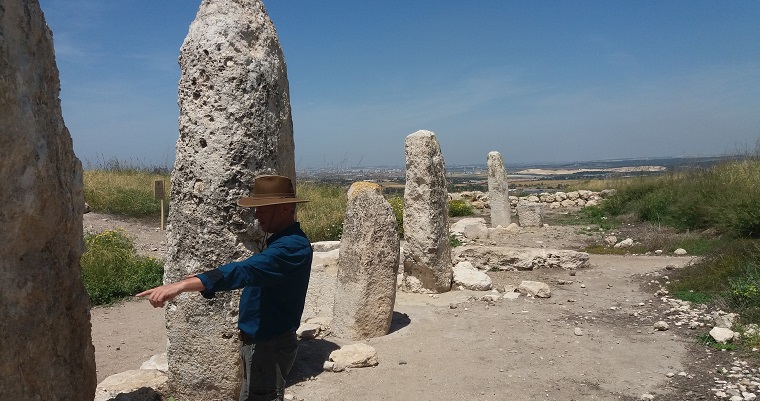
Significance and Sacredness of Stones
Megaliths are constructed from stones, which were often transported over great distances. Analogous to the human body, the stone corresponds to bones, which are white and hard. Bones, enduring beyond death, were revered as eternal and sacred in ancient times. This link between stone and bone is manifested in the practice of marking graves with stone tombstones, symbolizing the enduring nature of bones and their sacred significance.
The specific type of stone used in megalithic structures was likely of significant importance. For instance, the blue stones of Stonehenge were transported from 300 kilometers away in the mountains of Wales. Similarly, other stone circles in Britain, such as the Boscawen-un circle in Cornwall, feature stones of a special kind that were also brought from distant locations. In Israel, the notable collection of standing stones at Tel Gezer includes one stone that was sourced from Jerusalem, 50 kilometers away, underscoring the value placed on certain types of stones and the lengths to which ancient peoples would go to acquire them.
The earliest form of human belief is often considered to be paganism, a spiritual perspective where animate and inanimate objects, including animals and plants, were believed to possess their own spiritual essence or mana— a term denoting energy or a spiritual presence. According to this view, different stones carry distinct mana based on their material composition, a belief that is reflected in the energetic properties attributed to various gems. The origins of these beliefs prompt significant questions: Are they merely superstitions, or do different materials, including stones, genuinely embody distinct spirits and energies? This inquiry touches on the intersection of spiritual belief systems and the material world, exploring whether the attributes assigned to these materials are metaphysical interpretations or if they reflect an intrinsic property of the materials themselves.
Paul Devereux’s research indicates that specific kinds of stones possess unique acoustic qualities, which influenced their selection for megalithic structures. A prime example is the blue stones of Stonehenge, transported from a considerable distance because the complex functioned like a massive xylophone during regional ceremonies. This raises the possibility that, alongside acoustic characteristics, the stones may have been selected for their energetic properties as well.
Most would concur that a stone house evokes a different ambiance compared to a wooden house, and that the sensation of being amidst rocks differs from that of being in a forest. Extending this observation, it’s reasonable to suggest that the experience of being among basalt rocks differs from that among limestone rocks. Although such distinctions might not be scientifically verifiable, many would agree with these sentiments. People who lived closer to nature relied heavily on their senses and intuitions, experiencing the essence of stones with much greater intensity and sharpness than we typically do today.
Whether stones possess energy, as suggested by alternative theories and various folklore legends, remains a topic of debate. However, when it comes to sensory experiences and the sacred perceptions of ancient peoples, stones were indeed believed to embody energy, leading to the widespread practice of stone cults globally. The ancients held that stones contained a spirit or soul, often associating this belief with ancestor worship. They perceived the soul of the deceased as residing within the stone, safeguarding it from destruction and directing its power towards the Earth’s fertility. This view underscores the deep spiritual and symbolic significance attributed to stones in ancient cultures.
The primary consideration in discussing megaliths, which many experts seem to overlook, is the significance of stones to humans, especially from religious and symbolic perspectives, and possibly in terms of energy as well. The concept of stones as conduits of energy is a recurring theme across various cultures and religions, from ancient Egypt and Judaism (evidenced by the high priest’s breastplate) to Eastern traditions and isolated cultures with no ties to Western civilization, like the Australian Aboriginals. This widespread belief suggests two possibilities: either stones indeed possess the capacity to channel energy, or they are universally perceived by humans to have such properties, even if subconsciously.
In British folklore, numerous tales recount glowing stones, captivating those who hear them. Paul Devereux, delving into these stones and their stories, concluded that natural lights, generated by magnetic phenomena, particularly in regions with geological fractures, might explain these legends. He proposed that, much like trees can attract lightning, standing stones could draw these natural lights to them, offering a plausible basis for ancient tales of luminous stones. Devereux suggests that ancient peoples might have had knowledge of how to attract atmospheric lights (similar to auroras) during specific times, casting a new perspective on the purpose behind constructing megaliths, especially standing stones and stone circles. Notably, many megalithic sites in Israel are found in areas with significant geological activity and fractures, such as the Golan Heights, supporting Devereux’s hypothesis.
Research indicates that the Earth’s magnetic field is indeed variable, experiencing fluctuations in strength and, over geological timescales, even reversals in polarity. This variability raises the intriguing possibility that the magnetic field in the past differed significantly from its current state, potentially influencing the functionality of megalithic structures. If the Earth’s magnetic field was stronger, weaker, or oriented differently in the past, it could have interacted with the megaliths in ways that are not observable today, perhaps activating them or enhancing their perceived energetic properties. This hypothesis aligns with theories that suggest ancient peoples may have had a profound understanding of the Earth’s natural forces and incorporated this knowledge into the placement and construction of megalithic sites.
Before delving into the various types of megaliths, it’s important to recognize that the construction of megalithic complexes, stone circles, dolmens, and menhirs often occurred in locations that were considered sacred well before their erection. In some instances, these sites featured natural megalithic formations, like giant rocks. At these ancient sites, natural rocks were sometimes sculpted to achieve a specific appearance, leading to the creation of places that appear as if arranged by giants. Examples include the Cheesewring in England and Beglik Tash in Bulgaria. Similarly, in Israel, there are notable sites in the Negev, such as Mount Karkom, where such ancient practices were undertaken, blending the natural landscape with human modifications to enhance their sacred significance.
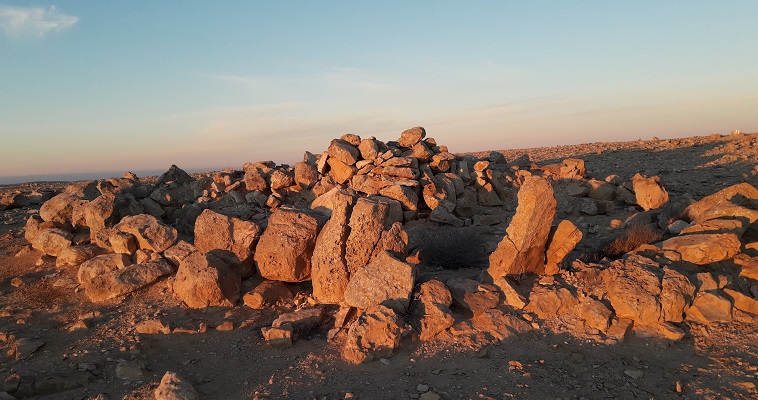
Standing Stones – Menhirs
Standing stones, known as Menhirs, are found globally, with thousands dotting landscapes across Europe, the Caucasus, and the Balkans. These colossal stones, some weighing tens of tons—with the largest Menhir tipping the scales at 330 tons—underscore the immense effort ancient peoples invested in erecting them. This widespread practice prompts the question of what motivated communities across the world to undertake such monumental tasks. The age of some Menhirs has been revised to be older than previously thought, adding depth to the mystery of their purpose and significance
On some of these standing stones, engravings can be found, and occasionally, objects believed to have magical properties are discovered buried beneath them. Typically, Menhirs are characterized by their narrow, tall, and rectangular shape, emphasizing two-dimensionality over three-dimensionality. However, variations exist, with some Menhirs being conical, cylindrical, or even low and wide, indicating a diversity in their design and purpose. Megaliths, in general, tend to exhibit free forms, showcasing the wide range of shapes and sizes that these ancient structures can take, reflecting the diverse cultural, spiritual, or functional intentions behind their construction and placement.
In Israel, numerous standing stones once dotted the landscape. However, due to dense settlement and an extensive history, many have been destroyed. For instance, until the 19th century, a large, ancient standing stone existed in the Valley of the Cross in Jerusalem, but it was used by the residents of the nearby village of Lifta for building their houses. Similar stones were also present in Lachish. The largest standing stone in Israel is located in Gezer, while many small and medium-sized standing stones are still found throughout the country, particularly in the Golan and Negev regions.
Often, one side of a Menhir is distinct from the other— one side may be rough while the opposite side is smooth, as observed with the standing stones in Gezer. Typically, these stones are oriented in specific directions, which may relate to celestial bodies like the sun or to terrestrial features. Frequently, there exists a connection between individual standing stones; they are aligned along the same line, even over distances, creating a visual or symbolic line of sight between them. This arrangement suggests an intentional design, possibly for astronomical, spiritual, or geographical purposes.
Symbolically, Menhirs can be considered the world’s axis, serving as a connection between heaven and earth. They are also seen as representations of the phallic male element, symbolically fertilizing the earth. Energetically, they resemble needles inserted into the Earth’s energy lines or meridians, which dictates their precise placement. Moreover, standing stones evoke the image of a human standing upright, possessing qualities that are reminiscent of human characteristics, and have been utilized across various cultures to symbolize human figures. This connection to human representation has influenced the development of the Matzevot (small standing stones) culture that was prevalent in prehistory across the Negev, leading to the contemporary practice of marking graves with tombstones (Matzevot).
Furthermore, in shamanic experiences involving trance, during which practitioners exit their bodies for astral travel, it has been reported that protruding rocks serve as navigation points in the non-physical realm. Lewis-Williams has demonstrated that ancient peoples engaged in shamanic experiences, facilitated either through the use of hallucinogenic plants or through religious rituals. Consequently, it is plausible that large standing stones acted as landmarks in the non-physical, supersensible world encountered during spirit journeys, providing points of orientation or significance within these transcendental experiences.
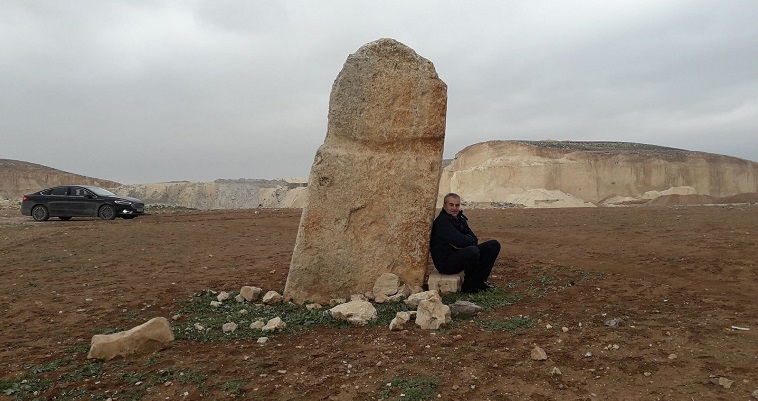
Dolmens as architypes
Dolmens consist of an artificial arrangement of three or more large stones forming a structure akin to a gate or house, topped with a massive flat rock resting on two or more upright stones. The world’s earliest dolmens are around 7,000 years old, although precise dating is challenging. This difficulty arises because dolmens are made of stone, and any organic materials discovered within them might originate from times after or subsequent their construction. In Britain, the earliest dolmens are found on the west coast of Wales, dating back over 6,000 years.
In Israel, over 6,000 Dolmens have been identified, with the oldest dating back to the 5th millennium BC. An illustrative example is found at the Murayghat Hajr al Mansub site near Madaba, in Transjordan, which hosts hundreds of massive Dolmens, alongside remnants of stone circles, cyclopean walls, Menhirs, and more, all dating back to the era associated with Goddess worship. A significant number of Dolmens are also located in the Golan Heights and the adjacent regions of the Jordan Valley.
Dolmens around the world symbolize an archetype ingrained in our collective consciousness. If a standing stone symbolizes an individual and a circle of stones represents a community or tribe, then a dolmen signifies a home—not merely in the conventional sense, but as a connection to the beyond, an eternal dwelling, or a portal to another realm. Thus, a dolmen embodies both a home and a gateway, reflected in its very structure.
Dolmens were primarily used as burial places, with some containing remains of skeletons and offerings. It is possible that the burials within dolmens were secondary, meaning the bones were placed in the dolmen after the body had decomposed. There’s also a chance that individuals were buried in dolmens at a later time than their construction. Generally, it seems dolmens served as burial sites in most cases and places, but this doesn’t exclude them from having additional functions concurrently.
At times, the Dolmen resembles a massive stone table or bed, suggesting it was constructed to support something placed on top of it. Often, these dolmens feature large stones weighing tens or even hundreds of tons as the upper stone, requiring significant effort to transport and lift. The choice of heavy horizontal stones for the roof indicates a purpose, whether symbolic or practical. I propose that the selection of hefty stones for the dolmen cover extends beyond mere physical considerations, as dolmens could have been constructed using lighter materials such as wooden beams and thatch, similar to houses. Evidently, activities associated with dolmens took place both on the top stone, symbolically linked to the sky, and beneath it, symbolically linked to the earth. I will elaborate further on this concept in the context of the large dolmen near Kibbutz Shamir.
While many dolmens consist of two standing stones supporting a large top stone forming a roof-like structure, there are instances where a third and even a fourth standing stone encloses the space, creating a more closed environment. Typically, these enclosed dolmens feature an opening on one side, sometimes carved into one of the enclosing stones resembling a window or door. This house-like appearance of dolmens can be observed in various locations, including Bulgaria, Abkhazia, and the Damiya Bridge area in Jordan.
Occasionally, multiple dolmens are connected in a series, forming a row resembling a line of gates. These linked dolmens create a long corridor covered with earth, known as a long barrow in English, which symbolically mirrors a woman’s womb. Such dolmen structures have been discovered in the Golan region, including the renowned burial chamber in Rujum Hiri. This configuration likely relates to the concept of the Sacred Feminine, associated with overseeing the processes and rituals of transitioning from the earthly realm to the afterlife—the realm beyond.
Some theorists propose that dolmens served not only as burial sites but also as locations for sanctification and initiation, suggesting that individuals entered them to undergo spiritual journeys and rites of passage. This interpretation does not necessarily contradict their function as burial places. Some dolmens feature spaces larger than required for burial, with enough room for standing—an example being the large dolmen in Kibbutz Shamir and the tank dolmens in Hurvat Batra. It is conceivable that as part of the shamanic practices within Goddess culture, shamans underwent a ritual of death and rebirth by spending time in a dolmen after experiencing ecstasy and initiation rituals, often facilitated by the use of hallucinogenic plants. Being within such a structure may have enhanced the trance experience. Additionally, dolmens might have stimulated specific thought patterns and served as aids for meditation and communication.
Devereaux conducted research on dreams experienced inside dolmens and discovered that statistically, individuals reported significant dreams, including more out-of-body experiences, when sleeping inside dolmens compared to a similar control group.
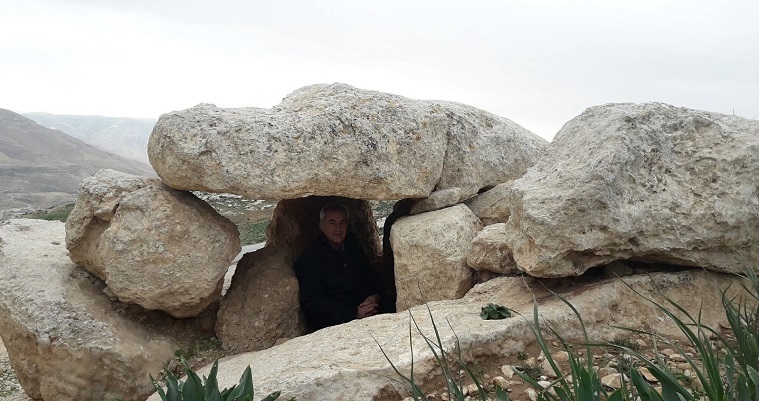
The sanctity of Dolmens
In the past two decades, a neo-pagan movement known as Anastasia emerged in Russia, venerating the Dolmens of the Caucasus. This movement was initiated by Vladimir Megre, a Russian businessman who claimed to have encountered a shaman named Anastasia in the Siberian taiga steppes. According to his account, Anastasia imparted to him the secrets of life and the universe. Megre documented this knowledge in a series of ten books titled “The Ringing Cedars of Russia,” which subsequently became the foundational texts of a sizable and influential movement.
According to Megre, as relayed to him by Anastasia, the Dolmens scattered throughout the Caucasus region, particularly in Abkhazia, predate the pyramids and were constructed approximately 12,000 years ago. During this era, the spiritual link between the Earth and advanced celestial realms began to wane, prompting enlightened individuals to seek methods to restore it. The Dolmens described by Megre are distinguished by their enclosed nature, resembling small houses with narrow openings. He suggests that these structures were erected to accommodate individuals seeking to reconnect with primal truths amidst the prevailing forgetfulness of their era. These individuals, identified as shamans or enlightened beings, retreated to the Dolmens for perpetual meditation and self-sacrifice, aiming to uphold and facilitate the connection with the universe.
The enlightened individuals would enter the Dolmens, and then the opening would be sealed shut, enveloping them in total darkness and sensory deprivation. This environment allowed them to direct all their energy inward and establish a connection with the “Mind” of the universe and the destinies of humanity. With no means of return, their sole option was to transcend to another dimension, eventually departing from this world. Once the process of transition and enlightenment was complete, the Dolmens were consecrated, imbuing their space with profound thoughts and knowledge. Subsequently, others could remove the capstone, enter the Dolmen, and access everything that transpired within it, tapping into divine wisdom.
The spirit of wisdom still permeates the Dolmens to this day, and individuals can seek advice or guidance from them. Each Dolmen stands as a testament to the sacrifice made by great spirits for the betterment of future generations and the advancement of humanity. In today’s world, Dolmens hold significant importance for humans, and it is crucial to listen to them with an open heart, as they serve as repositories of invaluable information.
According to Megre, Dolmens act as “receivers of information,” and one can tap into this reservoir by sitting quietly next to them or inside them, expressing gratitude and openness. By contemplating a question, answers may manifest. Dolmens emit a unique radiation that engenders supernatural occurrences in their vicinity—phenomena traditionally linked to healing and prophecy. Previous generations revered Dolmens, attributing magical powers to them, thus weaving legends into folklore and mythology. As sacred entities, Dolmens were regarded with reverence and deemed untouchable.
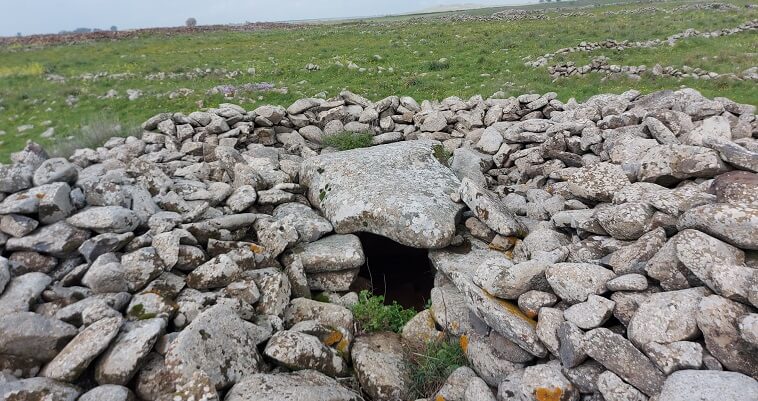
Types of Tumulus
In Israel, there exist various types of Tumulus, each with distinctive features. Tumulus found in the Negev region are typically circular in shape, with access points located from above. Conversely, Tumulus in the northern regions are characterized by mounds of stones containing either a Dolmen or a small chamber, with entrances positioned on the sides. The larger mounds or Tumulus in the north often house multiple Dolmens arranged lengthwise, akin to the long Barrows observed in Europe. Notable examples include the Dolmen near Kibbutz Shamir and the central mound in Rujum Hiri.
In Europe, over 40,000 Tumulus have been discovered along the eastern coast of the Atlantic Ocean, with their appearance dating back 7,000 years ago, spanning from Spain to Scandinavia, particularly prominent in the British Isles, including Ireland. These mounds likely served as burial sites and centers for Religious ceremonies. It’s plausible that their construction was associated with the spread of religion from Spain northward facilitated by seafarers. Some Tumulus contain multiple chambers, arranged in a cross shape. Certain inner chambers are subterranean, while others are at ground level, and many have undergone alterations and secondary uses over time. Typically, Tumulus are oriented along an east-west axis, with the burial chamber situated on the west side, lower than the entrance on the east side, bearing some resemblance to the Tumulus at the center of Rujum Hiri.
Freikman conducted excavations on several Tumulus structures with inner chambers in the Golan Heights, not far from Rujum Hiri. According to his findings, a Tumulus, or Rogam in Hebrew, represents a “sophisticated structure composed of multiple elements and necessitates careful planning.” The central chamber is constructed from large slabs, sometimes utilizing the false arch technique, and may have an oval or elongated shape with a corridor. Some Tumulus contain multiple rooms. Within the Tumulus mound, there are substantial stone walls arranged in concentric circles, filled with smaller stones, forming a symbolic hidden structure. Often, an outer circle of large stone slabs surrounds the mound, sometimes reaching significant heights. Freikman suggests that the Tumulus, akin to a world Mountain, incorporates a Dolmen as an integral component. In cases where only an exposed Dolmen is found without a Tumulus, it’s possible that it was originally part of a Tumulus, with the stones later repurposed by local residents.
In addition to the Tumulus structures with inner chambers, large piles of stones known as Cairns have been discovered in various locations in Israel, such as the Gal Jethro site near Parod. Recently, a massive Cairn was found submerged under the waters of the Sea of Galilee. This structure boasts a diameter of 70 meters and a height of 10 meters beneath the lake’s surface, located not far from Ohalo. It consists of approximately 60,000 tons of basalt stones, each measuring up to 1 meter in size, stacked on top of each other. The exact date of construction for this immense structure remains unknown, presenting one of the intriguing contemporary mysteries of the Land of Israel. Freikman plans to conduct a survey using ultrasound waves to determine if there is an internal chamber within the Cairn.
The difference between a pile of stones, known as a Cairn, and a Tumulus lies in the presence of an internal space. Cairns do not necessarily contain such a space. They can consist of various sizes of stones, arranged in layers or simply piled up. According to Paul Devereux, Cairns and Tumulus structures were constructed to amplify sounds. Some of their stones have acoustic properties, and the piling of them increases the overall acoustic effect. Some of the Tumulus’s resonates with the 111Hz frequency, which is associated with meditation and trance experiences. This frequency aligns with the Earth’s energy.
The Tumulus types found in the Negev region draw inspiration from ancient Megalithic structures known as “Noamis,” which emerged in southern Sinai around 6,000 years ago. The Noamis are circular buildings with a similar diameter to the Tumulus (up to 6 meters), but slightly taller (up to 2.5 meters), and they exhibit a more orderly construction. Inside, there is a round room with an opening towards the west, and they were primarily used for burials. It appears that, aside from burial purposes, the Noamis may have also served as sites for initiation ceremonies and shamanic rites.
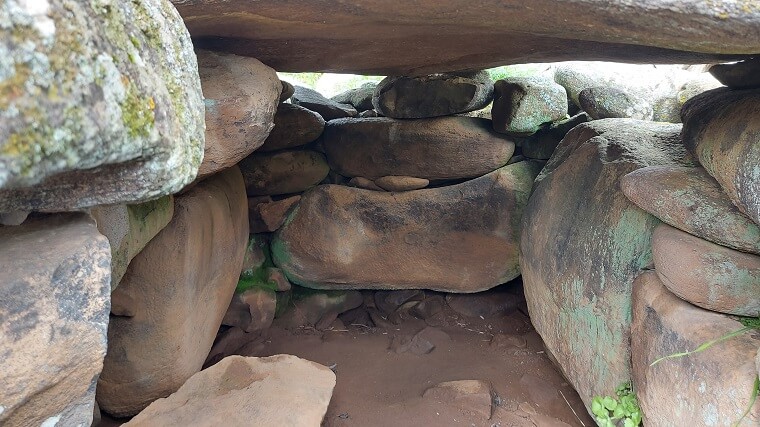
Ancient Stone Circles
A circle holds a deep archetype within our consciousness, symbolizing perfection and unity as it lacks a beginning and an end. In nature, we observe countless circles: the sun, the moon, the sky, the earth—all round. Life itself follows a circular path, returning to its origins. This notion reflects the myth of eternal return, as discussed by Eliade, where humanity, having fallen from the Garden of Eden, yearns for a return to that primordial state. This aspiration to reunite with the divine source from which we originated is inherent in the human Psyche.
The ancients constructed stone circles using standing stones and large circular mounds or earth embankments. Interestingly, they did not opt for shapes like squares or pentagons, highlighting the significance of the circle’s form. While they had various options for arranging the stones—such as the rows seen in Carnac, France, or laying them horizontally—the consistent use of circular shapes across Megalithic sites worldwide suggests a deeper meaning. These stone circles emerged during the time of the Goddess, with some of the earliest examples found in the Middle East.
Ancient stone circles are distinguished by their precise orientation towards celestial phenomena, including the sun, moon, and stars, marking significant days of the year and celestial events. Additionally, these circles often incorporate recurring measurements believed to correspond with earthly and human dimensions. This meticulous alignment with celestial bodies suggests a sophisticated understanding of the sky and its significance within the Goddess culture. For the ancients, the sky symbolized an orderly realm governed by the cycles of the moon, the motions of the stars, and the daily passage of the sun, all of which were mirrored in the design and purpose of stone circles.
Additional attribute of the Stone circles, is that they often exhibit orientations towards prominent natural features in the landscape, particularly mountains. This connection to the surrounding environment is a notable characteristic of these structures, exemplified by sites like Rujum Hiri. The circle is integral to a larger sacred complex, serving as a focal point within the landscape. Understanding the circle requires consideration of its relationship with the broader environment and its role within the sacred landscape.
One of the key aspects of stone circles is the implicit connection they establish between the masculine and feminine, the celestial and the terrestrial realms. Although situated on the ground, these circles are meticulously aligned to receive sunlight beams during sunrise or sunset on specific dates, such as the summer solstice at Stonehenge. This alignment symbolizes the union of sky and earth, male and female energies. The circular shape itself represents the feminine principle—nurturing, encompassing—while the incoming sunbeam embodies the masculine—active, focused. This gendered symbolism is evident even at a more basic level: the individual standing stones, forming the circle, represent the masculine—sturdy, enduring—while the collective circle embodies the feminine.
The circle holds a central role in the shamanic tradition, where continuous circular movements, like dances or the spinning of dervishes, aid in achieving trance states. Found in shamanic practices globally, the circle serves as a means to alter consciousness. With no discernible beginning or end, the circle becomes a potent tool for this purpose. Within the Goddess culture, people convened within stone circles, which were considered ideal settings for musical performances, circular dances, and rituals, including the sacred union ceremony, among the most significant.
Within the circle, various levels of sacredness often manifest, including nested circles or interconnected circles. The arrangement of these circuits, their interconnections, and their proportions are crucial. Every aspect of stone circles is meticulously crafted. If individual standing stones symbolize humans, then the circle represents the entirety of human society, akin to the symbolism of the round table.
Circles like Stonehenge in England and Rujum Hiri in Israel feature openings and what resemble “wire spokes,” oriented toward celestial bodies. Through these openings, influences such as sunlight or star energy “enter” the circle, especially on significant days like the summer solstice. Ceremonies held in stone circles on such occasions involved participants striking the resonant stones, turning the entire circle into a colossal xylophone, as described by Devereaux [5]. To truly grasp the significance of stone circles, they should not be viewed as lifeless structures but as vibrant places of worship. What’s truly remarkable (and often overlooked) is that the ancients contemplated the sky, the sun, and the stars, stirring within them a profound sense of spirituality
According to archaeological evidence, stone circles were closely linked to the cult of the dead. Burial grounds are often found in their vicinity, suggesting that on certain days of the year, these circles served as conduits for communication with the afterlife. It appears that the circles were sites where mystery plays and initiation rites unfolded, symbolizing death and resurrection for participants. Conversely, some argue that these circles hosted Sacred marriage ceremonies, given the inherent symbolism of male and female within them. Regardless of interpretation, it’s evident that stone circles were centers of religious assembly and served as a form of temple.
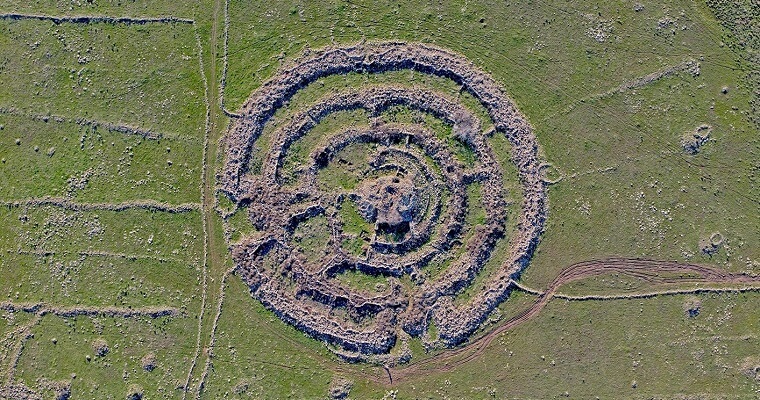
End Notes
[1] Freikman, Michael, M. (2014). Megalithic buildings in the southern Levant: the Golan Heights as a test case.
[2] In some parts of it, such as Ethiopia or Polynesia, it still exists today
[3] For example, the Phrygian Goddess Qibla is represented by a black stone that is brought to Rome during the Punic Wars.
[4] Freikman, Michael, M. (2014). Megalithic buildings in the southern Levant: the Golan Heights as a test case. p. 88
[5] Devereux, P. (2001). Stone Age Soundtracks : The Acoustic Archeology of Ancient Sites / Paul Devereux




